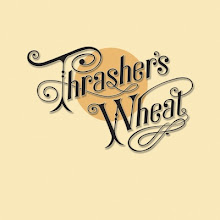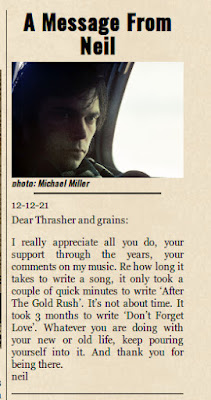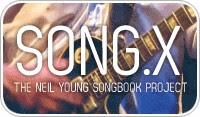Stevie Nicks Cover of Buffalo Springfield’s "For What It's Worth" + Essay by Harvey Kubernik
Stevie Nicks has released her take on Buffalo Springfield’s timeless protest song “For What It’s Worth”.
Stevie Nicks - For What It's Worth (Official Audio)
"Stevie Nicks just released her version of 'For What It's Worth.' When I saw Buffalo Springfield debut this tune in December '66 at the Santa Monica Civic Auditorium I didn't see this coming!
I had these interviews in my archive that I conducted and own that might work online about this epic tune. Portions appeared in my 2015 book 'Neil Young Heart of Gold,' currently published in 6 foreign language editions."
Stan Ross: (Engineer) On ‘For What It’s Worth’ it was a sound that I had worked on at our Gold Star recording studio. Buffalo Springfield did their first LP at our studio. They called me late at night to go up to Columbia studio and help fix the song. I was in Gold Star with engineer Tom May working with Sonny Bono on a song, ‘Sunset Symphony.’ Charlie Greene and Brian Stone called and said Buffalo Springfield had wanted to cut that night too, but the studio wasn’t available. I then received a call at 11:30 that night. ‘We’re in trouble. We’re sitting here and nothing is happening.’ Tom May and I went over to Columbia. The kids were on the floor, and having a good time. I have two hours and I have to get some sleep for a session tomorrow morning.
“I left at 2:00 A.M. after telling them ‘all you got to do is put the vocals here and put some guitar fills in.’ We didn’t have 8-track when Buffalo Springfield came in, that’s why they went to Columbia ‘cause they had a 8 track machine.
“I heard the song and had a great idea for the drum rhythm. I thought the drummer shouldn’t use his foot, and wanted someone to use a hand mallet. We have eight tracks here, and I want to be able to put the kick drum on track boom ‘Boom boom.’ boom boom. And I wanted to take the guitar and wrap some paper around the frets and I wanted a back beat. Not using the drum but using the back beat of the frets of the guitar. That’s a sound and technique I worked on at Gold Star many years ago. A very crispy wonderful sound. So we put together the rhythm sound, basically. After we got the track sounding like a track at 2:00 a.m. I said, ‘look guys, all you got to do is get the vocals around here and put some fills in between the vocals.’
“The next morning I got a phone call from (Atlantic Records) Ahmet Ertegun. ‘I got the record. The guy did a job in the studio, and I want you and Phil Spector to listen to two mixes. And I want you and Phil to tell me which mix you like.’ So Phil came down to Gold Star. CBS sent over mix one and mix two. And Phil and I listened, looked at each other and agreed, and that’s the record that came out.”
Dickie Davis: (BS Road Manager) I remember, maybe after Gold Star, going to Columbia. They laid down the tracks. Stephen sang the vocals, there were some background vocals worked out, Neil’s contribution of the harmonics, were done by plugging straight into the board in the studio. The clarity of those notes have to do with there’s not an amplifier and a microphone involved. It wasn’t almost a technical decision. It was kind of like Neil’s gonna sit in the booth and do this.
You know. It might have been that simple. I loved the playback. It was a well recorded tune.
Now, it wasn’t a ‘Beatles-style’ dance tune. Which was what we thought we had to do to be successful. It was a protest song and Stephen, the minute that song was a success. He started complaining, ‘Everybody is gonna think we’re a two bit protest band!’ And I would say things to him like, ‘Stephen, you wrote the song,’ you know. ‘It’s a success. It’s a hit!’
Kirk Silsbee (Writer): I don't know who arranged 'For What It’s Worth' but the pacing was brilliant. I think Dewey Martin has a great role on that particular record, and Bruce is also playing pretty minimal stuff. Of course, we know they could both play far more. It’s just a stark well-paced lament. Think about it this way: this is a hit record that went top ten. That’s pretty remarkable in itself. It was a hit record that had a very long shelf life and is still being played, discussed and sampled many years later. But in the middle of Hit Record Land, where everything had to be moving and they wanted bright colors and bright sounds in the music, this is a dead slow serious lament. It’s contrary to everything around it.”
Dickie Davis: ‘Clancy’ sinks and drowns and the Buffalo is stunned. Greene and Stone thought we’re gonna release an album and have the next Beatles. Everybody is gonna be wealthy. ‘Clancy’ was poorly recorded. By the way, there were background vocals that never got put on because there was no room on the tracks. A poor job of recording and not a success. We were broke. We didn’t have a dime.”
Brian Stone: We were friends with Ron Jacobs, the program director at KHJ. Part of the RKO radio chain that changed formats in the spring of 1965. In April of 1966, Sonny & Cher, along with Bob Lind, who we managed. Were part of a KHJ benefit concert at the Hollywood Bowl. In July of 1966, Buffalo Springfield opened for the Rolling Stones at the Hollywood Bowl. KHJ was very involved but the booking was probably through William Morris.
“The problem with Buffalo was that clash between Stephen and Neil. Having these two dynamic, talented incredible mighty playing forces like this, Ahmet (Ertegun) used to say to me all the time, we had hit records with him at Atlantic with Sonny & Cher, ‘I Got You Babe,’ and that ‘next to the Beatles, Buffalo Springfield were the best American rock group ever of all time.’ It was very rare to have two, if you want to include Richie Furay as well, three extraordinary singers, players in the same group.
“We got Neil Young his first Gretsch guitar. But I think we got that and a lot of equipment for Buffalo Springfield from Wallichs Music City in Hollywood. As managers we did things for our groups. That was from management and not the recording part. They would give us equipment and we would promote them. We would get a lot of instruments from them. Some of them we would have to buy. The guys would freak out and be happy."
Rodney Bingnheimer was a music reporter for Go magazine and worked record promotions for Nik Venet, based at Capitol Records. Rodney was a Gold Star regular and invited guest attending countless Charlie Greene and Brian Stone produced Sonny & Cher sessions at the studio.
"Charlie and Brian were always at Gold Star. They always knew how to dress. They had clothes from Beau Gentry on Vine Street. I loved Buffalo Springfield. I always saw them at the Whisky A Go Go. It was a ‘jangly’ folk sound. Sort of ‘Byrdsy’ in a way. ‘Country Byrds.’ They would gig all over Hollywood: The Troubadour, Hullabaloo. I liked the first album. ‘Clancy’ was incredible. ‘Down To The Wire.’ Charlie and Brian were really good behind the board. I liked them as record producers," says Rodney. "They were kind of mysterious and had a black Lincoln Continental limo.
"Greene and Stone were on top of it and got their people into the best studios and on all the best tours. They knew how to hustle and were really good on the telephone.
"At Gold Star everyone was wearing Levis and some buckskin things, Fairchild moccasins. Dewey Martin liked to wear velours. Always lurking was Ahmet Ertegun at all the sessions I was at from Sonny & Cher through Iron Butterfly. He was like a Turkish monk sitting in the corner," describes Bingenheimer. "A guy with a goatee. He always had suits on. He came by limo.
"Ahmet was around the Sonny & Cher sessions. It took me a couple of years to figure out he was the record company guy. Ahmet would never intrude and everyone was always around him and patting him on the shoulder. Cher would sit on his lap. It took me a while to learn he had the checkbook. He grooved on the music. He did seem older than everybody. He was scouting talent. He wasn’t a snob. He was very approachable.
‘I always saw Buffalo Springfield at the Whisky A Go Go. It was a ‘jangly’ folk sound. Sort of ‘Byrdsy’ in a way. ‘Country Byrds.’ But not the Byrds or a Country band. Or a folk thing. Buffalo Springfield were amazing on stage. They were rock, but weren’t rock ‘n’ roll. They would gig all over Hollywood: The Troubadour, Hullabaloo. People on the Whisky a Go Go dance floor really paid attention when they did ‘Nowadays Clancy Can’t Even Sing.’ The jangly guitars would ring real loud in the club.
"The first album didn’t really capture the Buffalo Springfield on stage," admits Rodney. "Just a little. I did go to Columbia studios and saw the mix of ‘For What’s It’s Worth’ happening. Pretty amazing.”
Ritchie Furay (BS band member) “The band was that first album and it was never captured again,” states Buffalo Springfield co-founder, Richie Furay. “That album represented the five of us together in the studio. After that it started to fall apart. It got worse with the next two albums. There were a lot of people being used other than the five of us.”
“There are songs and demos from guys who are part of your life, ‘cause people make bands a part of their life. Then, there are those fans and collectors who can say, ‘wow! I can get another charge now, not just hearing ‘For What It’s Worth’ for the 20th time. Or not just hearing a new mix of one of the songs. There’s something new for me to grab on too.
“We were always comfortable singing someone else’s song early on. The first album and some of the second, you can hear the cohesiveness was a group effort, there was not the possessiveness of ‘this is my song, ‘ ‘this is my baby, ‘I’m singing it because I wrote it.’ Early on there was this ‘what does this sound like with you singing?’ I know we tried ‘Mr. Soul’ with everybody singing and it sounded best with Neil. The individual members brought their own take on what was being presented to the song. We liked The Beatles with John and Paul singing harmony. Stephen and I did a lot of that unison singing. That we picked up from The Beatles but then there was a lot of experimentation."
- 50th Anniversary of Crosby, Stills, Nash & Young's "Deja Vu"
- 50th Anniversary of Neil Young's "After The Gold Rush"
- REVIEW: "WHAT'S THAT SOUND? Buffalo Springfield Box
- Buffalo Springfield's "Last Time Around" by Harvey Kubernik
Also, check out "A History of Music in 500 songs, Episode 152: For What It's Worth."
Incredible podcast, I don't listen to those things so I read the transcript, it is amazing. The details are vivid. I cannot recommend highly enough, elimination of BS surrounding the Springfield and then the intricate detail about who was around influencing who?
Abner - Oh you've hit a goldmine here.I listened to the podcast (all 1hr 50 mins) and was amazed to hear a British accent taking me through a detailed BS history. The tone of delivery is more a lecture than a chatty podcast with rather dry asides (I like this and is cultural appropriate for me), the detail is extraordinary and the music excerpts, especially the more obscure tracks, fill in the detail. The format describes the events leading up to the significant song in the title, so we get the whole back story of BS and more on the LA scene at the time."
Labels: album, buffalo springfield, neil young, review, stephen stills


































 Human Highway
Human Highway

















 Concert Review of the Moment
Concert Review of the Moment





 This Land is My Land
This Land is My Land

 FREEDOM In A New Year
FREEDOM In A New Year









 *Thanks Neil!*
*Thanks Neil!*




![[EFC Blue Ribbon - Free Speech Online]](http://www.thrasherswheat.org/gifs/free-speech.gif)











 The Unbearable Lightness of Being Neil Young
The Unbearable Lightness of Being Neil Young Pardon My Heart
Pardon My Heart



 "We're The Ones
"We're The Ones  Thanks for Supporting Thrasher's Wheat!
Thanks for Supporting Thrasher's Wheat!




 This blog
This blog 
 (... he didn't kill himself either...)
#AaronDidntKillHimself
(... he didn't kill himself either...)
#AaronDidntKillHimself









































































 Neil Young's Moon Songs
Neil Young's Moon Songs




 Civic Duty Is Not Terrorism
Civic Duty Is Not Terrorism Orwell (and Grandpa) Was Right
Orwell (and Grandpa) Was Right


 What's So Funny About
What's So Funny About 



6 Comments:
Totally off topic here, but I gotta talk about KPIG radio out here in Santa Cruz county. I work at a store that plays KPIG over the speakers, and you guys can't believe the amount of Neil, and the different songs of his that they play.
Right now they are playing Bandit. In the last couple days alone, I've heard Look Out For My Love, Change Your Mind, Razor Love, Needle and Damage Done, Birds, and Prarie Wind.
If there's another radio station anywhere on this planet that plays those type of Neil tunes, please let me know. I kind of highly doubt it.
Nice enough, Stevie Nicks's interpretation, although still far removed from the kind of quasi-cheerful tongue in cheek BS version.
(Anyway I guess it is hard to ruin that song ..).
But a protest song?
I thought that image was flogged to death already? But I may be wrong (nobody's right after all).
On the other hand, if a protest song is what other people made of it, it's true, whatever the politics of Stephen Stills.
Cheers from the European delta.
Post some more interesting Neil-thoughts, friends. Otherwise it may become a cold lonely Winter.
@ Richie - off topic is ok if neil related. :)
glad to hear good ol KPIG is still cranking along.
@ Minke - we strongly urge you to listen to the podcast linked above:
"A History of Music in 500 songs, Episode 152: For What It's Worth."
can't recommend highly enough on this subject of FWIW as a protest song.
the guy doing the podcast addresses this right at the outset on why FWIW is a protest song w/ all of the background on the Sunset Strip. very essential.
O well. If "For what it's worth' is a protest song, in the sense that a big societal mishap is being courageously addressed, my name is Stokely Carmichael. Come on Thrasher, I immensely respect you in every way, but let's be open and argumentative and not stifle our critical thinking into a too meek fandom. Or endlessly repeat idées reçues from middle class consumers who think drinking herbal tea is an act of defiance.
As Robert Christgau aptly remarked: "Until the very end of the decade even the best-remembered explicitly political songs--Buffalo Springfield's "For What It's Worth," the Beatles' "Revolution," the Rolling Stones' "Street Fighting Man"--are ambiguous in an amazingly studied and deliberate way, not just to get them on the radio but because the artists are in fact ambivalent about politics. As Stephen Stills put it, "Something is happening here/What it is ain't exactly clear." (See https://www.robertchristgau.com/xg/music/princeto.php)
Talking about protest songs, I have always thought "Ohio" to be a terrific and powerful song, but in the context of a war in which hundreds of thousands Vietnamese died a bit uhhh, limited. (Which does not deny that every violent death is a tragedy in itself.)
Thanks for your tremendous work!
Greetings from the world zone where not protest songs, but Russian energy strategies are going to make the difference for the climate.
Salam
@ Minke - sincere thanks here for reply.
and we do appreciate your encouragement and being here.
So, FWIW, "a protest song, in the sense that a big societal mishap is being courageously addressed." and we disagree here politely.
FWIW is as significant as Ohio.
Did you actually listen to "A History of Music in 500 songs, Episode 152: For What It's Worth." linked above?
It makes an impressive case. Via transcript:
"One of the things you notice if you write about protest songs is that a lot of the time, the songs that people talk about as being important or impactful have aged very poorly. Even great songwriters like Bob Dylan or John Lennon, when writing material about the political events of the time, would write material they would later acknowledge was far from their best.
Too often a song will be about a truly important event, and be powered by a real sense of outrage at injustice, but it will be overly specific, and then as soon as the immediate issue is no longer topical, the song is at best a curio."
[clips]
"And because of that emotional connection, sometimes the very best protest songs can take on new lives and new meanings, and connect with the way people feel about totally unrelated subjects.
Take Buffalo Springfield’s one hit.
The actual subject of the song couldn’t be any more trivial in the grand scheme of things — a change in zoning regulations around the Sunset Strip that meant people under twenty-one couldn’t go to the clubs after 10PM, and the subsequent reaction to that — but because rather than talking about the specific incident, Steve Stills instead talked about the emotions that it called up, and just noted the fleeting images that he was left with, the song became adopted as an anthem by soldiers in Vietnam.
Sometimes what a song says is nowhere near as important as how it says it."
again, we can't really improve on what is being said about FWIW and it's significance as a protest song.
thanks again for opp here to discuss a most important topic.
btw, anyone heard any good protest songs concerning Ukraine?
3,2,1
thought so.
https://neilyoungarchives.com/video?id=5PCU43REekMem02eMQSUie
Post a Comment
<< Home